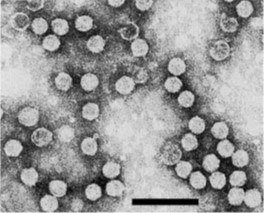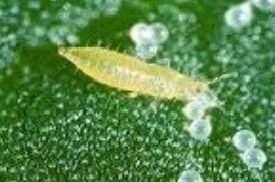Causes & Transmission
Causes
MLN is typically caused by the synergistic interaction between maize chlorotic mottle virus (MCMV)

Electron-micrograph of MCMV
and any cereal Potyvirus e.g, sugar cane mosaic virus (SCMV), maize dwarf mosaic virus (MDMV) or wheat streak virus (WSMV). MCMV or SCMV typically produce milder symptoms when they infect maize alone; in combination, these two viruses rapidly produce a synergistic reaction that seriously damages or kills infected plants.
Maize plants are susceptible to MLN at all growth stages, from seedling to maturity. Transmission of the viruses causing MLN is through insect vectors. Transmission of MCMV via infected or contaminated seed also occurs. Early reports from the USA indicated seed-borne transmission of MCMV only occurs at very low frequency, however results from East Africa indicate a much higher frequency. Detailed investigations on the importance of seed-borne transmission mechanisms in East Africa are on-going.
Transmission Mechanisms
There are 4 principle mechanisms by which MLN causing viruses can be transmitted.

Immature corn thrip
1. Insects
MLN causing viruses can be transmitted by a range of insect vectors; including thrips and chrysomelid beetles for MCMV and predominantly aphid species for potyviruses. The range of insect species known to transmit MLN causing viruses are:
• Aphids (Aphis gossypii, Myzuspersicae)
• Corn Thrips(Frankliniellawilliamsi)
• Corn flea beetle (Chaetocnema pulicaria)
• Southern corn rootworm (Diabroticaundecimpunctata)
• Northern corn rootworm (D. lonicornis)
• Western corn rootworm (D. virgifera)
• Flea beetle (Systenafrontalis)
• Cereal leaf beetle (Oulemamelanopa)
2. Infected or Contaminated Seed
Early reports from the USA indicated seed-borne transmission of MCMV or SCMV only occurs at very low frequency (MCMV = 17/42,000 plants (0.04%); SCMV = 21/72,897 plants (0.03%) Jensen et al 1991). However initial results from East Africa indicate a much higher frequency. Detailed investigations on the importance of seed-borne transmission (infected or contaminated seed) in East Africa are on-going.
3. Infected Soil and Plant Debris
4. Mechanically – via infected field implements, machinery etc
